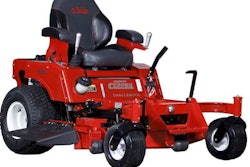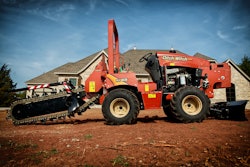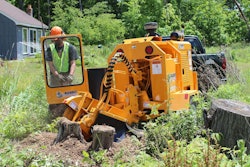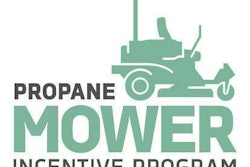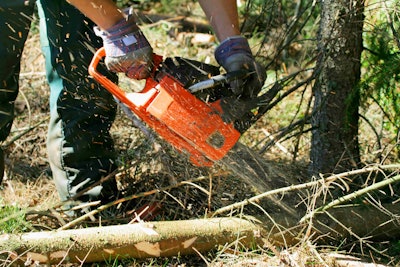
Working with chainsaws is nothing to take lightly, and landscapers should be training workers properly on how to operate the machines.
“I think some of the basic tips when it comes to working with chainsaws is you need to look at the chainsaw manual, which obviously is going to vary from manual to manual,” says Jose Cantú, owner of Saw House in Texas and a National Hispanic Landscape Alliance member. “If you look through a manual now or even 20 years ago, there is so much information. You can even go online and find information.”
To find the right chainsaw, landscapers should work with local dealers to find the right chainsaw for the job. There are a variety of units out there that cover everything from professional tree work to everyday light work.
No matter the unit, chainsaws have two basic positions where workers need to hold the saw – the rear guard and the front guard in front of the break, according to Cantú.
“The inspection includes making sure your chain is properly tensioned,” Cantú Says. “Nowadays, they have put a lot more regulations in the units with the vibration. Some of them are coming with buffers made out of hard rubber or metal springs that recoil and are able to absorb a lot of the vibrations.”
One of the most important things for workers to maintain is the chain itself. Whether landscapers have the chain sharpened by an authorized dealer or they do it in house, the chain needs to be very sharp before starting a job.
If the chain is sharp, operators do not need to apply pressure to make the cut. “The chainsaw should be doing all the work,” Cantú says.
Operators should be looking for nice large wood chips rather than a lot of dust. If there is dust, that’s a sure sign the chain is dull.
Right attire
Wearing personal protective equipment should be a must on every jobsite when chainsaws are in use.
PPE won’t fully protect an individual, but according to Cantú, it’s going to greatly reduce injuries.
Workers need to be wearing proper face and head projection, as well as eye and ear protection. There are also industry chaps that are six to nine layer chaps that prevent and reduce injuries.
“Some are made of different fibers and those chaps are worn by a lot of arborists or loggers,” Cantú says. “If they accidentally have a chain spinning at full throttle, it can’t lock the bar, the chain can go into the leg. It might create a bruise, but I’d rather have a bruise than no limb.”
Operators should also be wearing proper foot wear like steel-toed boots and always have a first aid kit, cell phone and a coworker nearby.
Handling the saw
Users should always handle the saw with two hands – never just one, according to Cantú.
For operators not familiar with a top-handle saw, it’s a common tendency to want to place one hand on the saw and one hand on the tree to create a balancing act. Because of this, two hands are not on the chainsaw, and it could kickback.
“When the chainsaw is spinning on the 12-o-clock end of the bar, if you touch that part to cut, it tends to create a kickback,” Cantú says. “No mater how big or strong you are, it’ll kickback.”
Operators should always have their left hand on the hand guard. If an operator pushes that guard, it engages a break that locks the bar and chain to keep it from spinning. If there is kickback and the operator’s hand is on the guard, it will collapse forward and stop the bar and chain before it hits the operator.
When using the front quadrant of the bar on the chainsaw, operators should ways use the back portion at full throttle. If operators cut with the tip, it will create a dangerous kickback effect. Additionally, users should never operate a chainsaw over shoulder height or reach out.
When it comes to starting the unit, it’s a common occurrence for operators to drop start the saw, Cantú says. “That chain is in full throttle, and I’ve heard horror stories of a knee or leg being clipped,” Cantú says. “A chainsaw should always be planted firmly on the floor with three positions – one is a foot, one hand is on the handle and the other is to start the engine.”
Because of the loud noise and PPE, workers should create hand signals to communicate with one another, as well as make sure the area is clear and safe before starting the chainsaw.
“When you’re out there, you should be aware of your surroundings,” Cantú says.
Additional training
Landscapers can always go through dealers that offer classes on how to properly operate chainsaws.
“We hold set up meetings, and we might do a preventative maintenance class on the units,” Cantú says. “I highly recommend any landscaping company go to their authorized dealer and touch base.”
For some of their classes, Cantú will even translate the classes into Spanish for some of the workers. Typically, the classes will lead to a question-and-answer session at the end.
“Don’t just have the training once a year,” Cantú says. “Try to do it twice a year right before the season starts. It has to be repetitive, and newer products are entering the market so it can help the guys keep up.”
Here are some additional tips from the Occupational Safety and Health Administration:
Before starting a chainsaw
- Check controls, chain tension, and all bolts and handles to ensure that they are functioning properly and that they are adjusted according to the manufacturer’s instructions.
- Make sure that the chain is always sharp and the lubrication reservoir is full.
- Start the saw on the ground or on another firm support. Drop starting is never allowed.
- Start the saw at least 10 feet from the fueling area, with the chain’s brake engaged.
Fueling a chainsaw
- Use approved containers for transporting fuel to the saw.
- Dispense fuel at least 10 feet away from any sources of ignition when performing construction activities. No smoking during fueling.
- Use a funnel or a flexible hose when pouring fuel into the saw.
- Never attempt to fuel a running or hot saw.
Chainsaw safety
- Clear away dirt, debris, small tree limbs and rocks from the saw’s chain path. Look for nails, spikes or other metal in the tree before cutting.
- Shut off the saw or engage its chain brake when carrying the saw on rough or uneven terrain.
- Keep your hands on the saw’s handles, and maintain secure footing while operating the saw.
- Proper personal protective equipment must be worn when operating the saw, which includes hand, foot, leg, eye, face, hearing and head protection.
- Do not wear loose-fitting clothing.
- Be careful that the trunk or tree limbs will not bind against the saw.
- Watch for branches under tension, they may spring out when cut.
- Gasoline-powered chain saws must be equipped with a protective device that minimizes chain saw kickback.
- Be cautious of saw kickback. To avoid kickback, do not saw with the tip. If equipped, keep tip guard in place.
